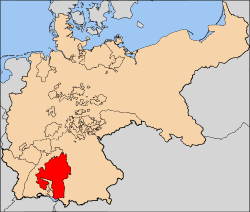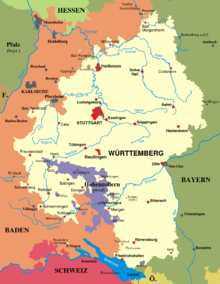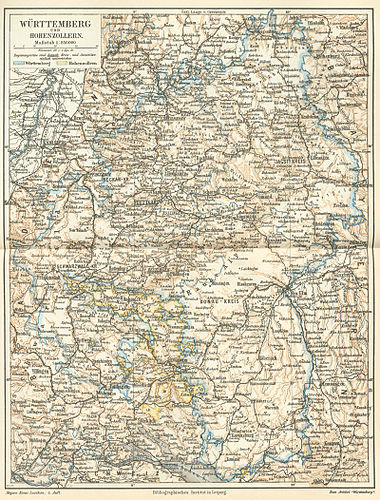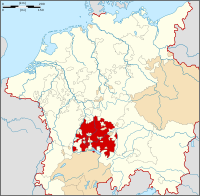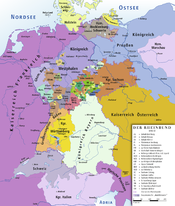- Württemberg
-
County (Duchy, Electorate, Kingdom) of Württemberg
Grafschaft (Herzogtum, Kurfürstentum, Königreich) WürttembergState of the Holy Roman Empire (until 1806) ← 
11th century–1918  →
→

Flag of the Kingdom of Württemberg Coat of arms of the Kingdom of Württemberg Württemberg, shown within the German Empire (1871–1918) Capital Stuttgart Language(s) Swabian German Religion Lutheran and Catholic Government Monarchy King -
ca 1089–1122
(first count)Conrad I - 1457–1496
(first duke from 1495)
Eberhard I (V)- 1797–1816
(first king from 1806)
Frederick I (III)- 1891–1918
(last king, died 1921)
William IIHistorical era Middle Ages - County founded
by Conrad I
before 1081- Treaty of Nürtingen
divides county
1442 11th century- Treaty of Münsingen
reunites county
1482- Raised to duchy 1495 - Raised to electorate 1803 - Raised to kingdom 1806 - Monarchy overthrown November 9, 1918 1918 The title of this article contains the character ü. Where it is unavailable or not desired, the name may be represented as Wuerttemberg.Württemberg (German pronunciation: [ˈvʏɐ̯təmˌbɛɐ̯k]), formerly known as Wirtemberg or Wurtemberg, is an area and a former state in southwestern Germany, including parts of the regions Swabia and Franconia.
Its traditional capital was Stuttgart. For short periods of time, the seat of the government was located in Ludwigsburg and Urach. The name of the dynasty and the state originates from a steep Stuttgart hill, close to Stuttgart-Untertürkheim. Now the region is part of the German state of Baden-Württemberg.
Contents
History
Württemberg, once a Duchy within the Holy Roman Empire, in 1806 became the Kingdom with the break-up of empire. This was during the reign of Frederick I of Württemberg. In 1918 it became a republic called the Free People's State of Württemberg.
After World War II, Württemberg was divided between the United States and French occupation zones and became part of two new states: Württemberg-Baden and Württemberg-Hohenzollern. After the Federal Republic of Germany was formed in 1949, these two states merged with Baden in 1952 to become the modern German state of Baden-Württemberg.
Geography
It lies between 47° 34' 48" and 49° 35' 17" N, and between 8° 15' and 10° 30' E. Its greatest length from north to south comprised 225 km (140 mi); its greatest breadth comprised 160 km (99 mi); its boundaries had a circumference of 1,800 km (1,100 mi). Its total area comprised 7,534 square miles (19,510 km2). It shared a boundary on the East with Bavaria, and on the other three sides with Baden, with the exception of a short distance on the South, where it bordered Hohenzollern and Lake Constance.
Climate
The temperate climate turns colder among the mountains in the south. The mean temperature varies at different points from 6 to 10°C (43–50°F). Abundant forests induce much rain, most of which falls in the summer. Given on the whole fertile and well-cultivated soil, agriculture formed the main occupation of the inhabitants.
Demography
Agriculture
The Kingdom of Württemberg essentially formed an agricultural state, and of its 4,821,760 acres (19,513.0 km2), 44.9% comprised agricultural land and gardens, 1.1% vineyards, 17.9% meadows and pastures, and 30.8% forest.
It possessed rich meadowlands, cornfields, orchards, gardens, and hills covered with vines. The chief agricultural products were oats, spelt, rye, wheat, barley, and hops. To these add wine (mostly of excellent quality) of an annual value of about one million pounds sterling, peas and beans, maize, fruit, (chiefly cherries and apples), beets and tobacco, and garden and dairy produce.
Württembergers reared considerable numbers of cattle, sheep and pigs; and paid great attention to the breeding of horses.
Württemberg has a long history of producing red wines, although from somewhat different varieties than other German wine regions. Today the region of Württemberg is a designation (Anbaugebiet) for quality wine in Germany,[1] separate from the wine region of Baden. With 11,522 hectares (28,471 acres) under viticulture in 2006, Württemberg is Germany's fourth largest wine region.[2] Winemaking cooperatives are responsible for almost 75% of the region's production.[3]
The Württemberg wine region is centered on the valley of the Neckar and several of its tributaries, Rems, Enz, Kocher and Jagst.
Mining
The Kingdom of Württemberg lacked minerals of great industrial importance apart from salt and iron. The salt industry came to prominence only at the beginning of the 19th century. The iron industry, on the other hand, had great antiquity, but completely lacked coal mines within the Kingdom. Other minerals produced included granite, limestone, ironstone and fireclay.
Manufacturers
The old-established manufacturers embraced linen, woolen and cotton fabrics, particularly at Esslingen and Göppingen, and paper-making, especially at Ravensburg, Heilbronn and other places in Lower Swabia.
The manufacturing industries, assisted by the government, developed rapidly during the later years of the 19th century, notably metal-working, especially such branches of it as require exact and delicate workmanship. Particular importance attached to iron and steel goods, locomotives (for which Esslingen enjoyed a good reputation), machinery, cars, bicycles, small arms (in the Mauser factory at Oberndorf), all kinds of scientific and artistic appliances, pianos (at Stuttgart), organs and other musical instruments, photographic apparatus, clocks (in the Black Forest), electrical apparatus, and gold- and silver-goods.
Extensive chemical works, potteries, cabinet-making workshops, sugar factories, breweries and distilleries operated. Water-power and petrol largely compensated for the lack of coal. Among other interesting developments note the manufacture of liquid carbonic acid gas extracted from natural gas springs beside the Eyach, a tributary of the Neckar.
Commerce
The Kingdom of Württemberg's principal exports included cattle, cereals, wood, pianos, salt, oil, leather, cotton and linen fabrics, beer, wine and spirits. Commerce centred on the cities of Stuttgart, Ulm, Heilbronn and Friedrichshafen. Stuttgart, once called the Leipzig of South Germany, boasted an extensive book trade. The kingdom had creative inventors; Gottlieb Daimler, the first car manufacturer, incorporated his business in 1900 as Daimler Motoren Gesellschaft, and its successor company Mercedes-Benz always had plants near Stuttgart. At Friedrichshafen on Lake Constance Count Ferdinand von Zeppelin constructed his airships from 1897 to his death in 1917.
Communications
In 1907 the Kingdom of Württemberg had 2,000 km (1,200 mi) of railways, of which all except 256 km (159 mi) belonged to the state. Navigable waters included the Neckar, the Schussen, Lake Constance, and the Danube downstream from Ulm. The Kingdom had fairly good quality roads; the oldest of them of Roman construction. Württemberg, like Bavaria, retained the control of its own postal and telegraph service on the foundation of the new German Empire in 1871.
Constitution
As a constitutional monarchy, the Kingdom of Württemberg functioned as a member of the German Empire, with four votes in the then Federal Council (Bundesrat), and seventeen in the Reichstag (parliament). The constitution rested on a law of 1819, amended in 1868, in 1874, and again in 1906. The hereditary crown conveyed the simple title of "King of Württemberg". The king received a civil list of 103,227 pounds sterling.
The Kingdom possessed a bi-cameral legislature. The upper chamber (Standesherren) comprised:
- adult princes of the blood
- heads of noble families from the rank of count (Graf) upwards
- representatives of territories (Standesherrschafien) which possessed votes in the old German Imperial Diet or in the local diet
- members (not more than 6) nominated by the King
- 8 members of knightly rank
- 6 ecclesiastical dignitaries
- a representative of the university of Tübingen
- a representative of the Stuttgart University of Technology
- 2 representatives of commerce and industry
- 2 representatives of agriculture
- 1 representative of handicrafts.
The lower house (Abgeordnetenhaus) had 92 members:
- 63 representatives from the administrative divisions (Oberamtsbezirke)
- 6 representatives from Stuttgart, elected by proportional representation
- 6 representatives, one from each of the six chief provincial towns
- 17 members elected by the two electoral divisions (Landeswahlkreise), elected by proportional representation
The King appointed the President of the upper chamber; after 1874 the lower chamber elected its own chairman. Members of both houses had to have reached twenty-five years of age.
Württemberg parliaments had terms of six years; all male citizens over twenty-five years of age possessed suffrage rights, voting by ballot.
The highest executive power rested in the hands of the Ministry of State (Staatsministerium), consisting of six ministers for:
- justice
- foreign affairs (with the royal household, railways, posts and telegraphs)
- the interior
- public worship and education
- war
- finance
The Kingdom also had a Privy Council, consisting of the ministers and some nominated councillors (wirkliche Staatsräte), who advised the sovereign at his command. The judges of a special supreme court of justice, called the Staatsgerichtshof (which functioned as the guardian of the constitution), gained office partly through election by the chambers and partly through appointment by the King. Each of the chambers had the right to impeach the ministers.
The Kingdom comprised four governmental departments (Kreise), subdivided into sixty-four divisions (Oberamtsbezirke), each under a headman (Oberamtmann) assisted by a local council (Amtsversammlung). A Government (Regierung) heads each of the four departments.
See also: Württemberg Landtag elections in the Weimar Republic
Ecclesiastical administration
The right of direction over the churches resided in the King, who had also, so long as he belonged to the Protestant Church, the guardianship of the spiritual rights of that Church. The Protestant Church is controlled (under the minister of religion and education) by a consistory and a synod. The consistory comprised a president, 9 councillors and 6 general superintendents or prelates from six principal towns. The synod consisted of a representative council, including both lay and clerical members.
The Roman Catholic Church in the Kingdom answered to the bishop of Rottenburg, in the archdiocese of Freiburg. Politically it obeyed a Roman Catholic council, appointed by government.
A state-appointed council (Oberkirchenbehörde) regulated Württemberg's Judaism after 1828.
Education
The Kingdom claimed universal literacy (reading and writing) over the age of ten years. Higher learning occurred at the university of Tübingen, in the Stuttgart University of Technology, the veterinary college at Stuttgart, the commercial college at Stuttgart, and the agricultural college of Hohenheim. Gymnasia and other schools existed in all the larger towns, while every commune had a primary school. Numerous schools and colleges existed for women. Württemberg also had a school of viticulture.
Army
Under the terms of a military convention of November 25, 1870 the troops of Württemberg formed the XIII (Royal Württemberg) Corps of the Imperial German Army.
State Finances
Until 1873 the kingdom and some neighbouring states used the "Gulden" as currency. From 1857 the Vereinsthaler was introduced alongside it, and from 1873 both were replaced by the Gold Mark.
The state revenue for 1909–1910 comprised an estimated 4,840,520 pounds sterling, nearly balanced by expenditure. About one-third of the revenue derived from railways, forests and mines; about 1,400,000 pounds sterling from direct taxation; and the remainder from indirect taxes, the post-office and sundry items.
In 1909 the public debt amounted to 29,285,335 pounds sterling, of which more than 27,000,000 pounds sterling resulted from the costs of railway construction.
Of the expenditure, over 900,000 pounds sterling went towards public worship and education, and over 1,200,000 pounds sterling went in interest and repayment of the national debt. To the treasury of the German Empire the Kingdom contributed 660,000 pounds sterling.
Namesake
Two naval ships of the German Imperial Navy were named after the state of Württemberg. The first SMS Württemberg was a Sachsen class armored ship launched in 1878. The second SMS Württemberg was a Bayern class battleship that was cancelled before completion before the end of World War I.
See also
- Alemannish
- Rulers of Württemberg
- Weizsäcker family
- Württemberg (wine region)
- Duke of Urach
Further reading
- Marquardt, Ernst (1985). Geschichte Württembergs (3rd ed.). Stuttgart: DVA. ISBN 3421062714. (German)
- Vann, James Allen (1984). The Making of a State: Württemberg, 1593-1793. Ithaca, NY: Cornell University Press. ISBN 0801415535.
- Weller, Karl; Weller, Arnold (1989). Württembergische Geschichte im südwestdeutschen Raum (10th ed.). Stuttgart: Theiss. ISBN 3806205876. (German)
- Wilson, Peter H. (1995). War, state, and society in Württemberg, 1677-1793. New York: Cambridge University Press. ISBN 0521473020.
References
- ^ Wein.de (German Agricultural Society): Wuerttemberg, read on January 1, 2008
- ^ German Wine Institute: German Wine Statistics 2007-2008
- ^ Wein-Plus Glossar: Württemberg, read on January 1, 2008
 This article incorporates text from a publication now in the public domain: Chisholm, Hugh, ed (1911). "Württemberg". Encyclopædia Britannica (11th ed.). Cambridge University Press.
This article incorporates text from a publication now in the public domain: Chisholm, Hugh, ed (1911). "Württemberg". Encyclopædia Britannica (11th ed.). Cambridge University Press.
External links
 "Württemberg". New International Encyclopedia. 1905.
"Württemberg". New International Encyclopedia. 1905.
 Swabian League (1488–1534) of the
Swabian League (1488–1534) of the  Holy Roman Empire
Holy Roman EmpireImperial Cities Aalen · Augsburg · Biberach · Bopfingen · Dinkelsbühl · Donauwörth · Esslingen · Giengen · Heilbronn · Isny · Kaufbeuren · Kempten · Leutkirch · Lindau · Memmingen · Nördlingen · Pfullendorf · Ravensburg · Reutlingen · Schwäbisch Gmünd · Schwäbisch Hall · Überlingen · Ulm · Wangen · Weil · Wimpfen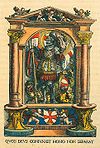
Nobility Territories Württemberg · Brandenburg-Ansbach · Baden · Bavaria · Bayreuth · Electoral Palatinate · Hesse · Mainz · Trier States of the Confederation of the Rhine (1806–13)
States of the Confederation of the Rhine (1806–13)Rank elevated
by NapoleonKingdomsGrand DuchiesStates created KingdomsGrand DuchiesPrincipalitiesPre-existing
statesDuchiesAnhalt (Bernburg · Dessau · Köthen) · Arenberg · Mecklenburg (Schwerin · Strelitz) · Nassau · Oldenburg · Saxony (Coburg-Saalfeld · Gotha-Altenburg · Hildburghausen · Meiningen · Weimar3 · Eisenach3 · Weimar-Eisenach4)PrincipalitiesHohenzollern (Hechingen · Sigmaringen) · Isenburg-Birstein · Liechtenstein · Lippe-Detmold · Reuss (Ebersdorf · Greiz · Lobenstein · Schleiz) · Salm5 · Schaumburg-Lippe · Schwarzburg (Rudolstadt · Sondershausen) · Waldeck1 from 1810. 2 until 1810. 3 until 1809. 4 from 1809. 5 until 1811. States of the German Confederation (1815–66)
States of the German Confederation (1815–66)Empires 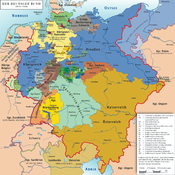
Kingdoms Electorates Grand Duchies Duchies Anhalt (Bernburg2 · Dessau2 · Köthen3) · Brunswick · Holstein · Limburg4 · Nassau · Saxe-Lauenburg · Saxony (Altenburg5 · Coburg-Saalfeld6 · Coburg-Gotha5 · Gotha-Altenburg6 · Hildburghausen6 · Meiningen)Principalities Hesse-Homburg · Hohenzollern (Hechingen7 · Sigmaringen7) · Liechtenstein · Lippe · Reuss (Elder · Junior) · Schaumburg-Lippe · Schwarzburg (Rudolstadt · Sondershausen) · Waldeck and PyrmontCity-states Other territories
outside of the
confederacyColonial possessions · Personal unions of Habsburg (Bukovina · Croatia · Galicia and Lodomeria · Hungary · Lombardy–Venetia · Serbian Voivodeship and Banat8 · Slavonia9 · Transylvania) · Personal union of Hanover (Great Britain and Ireland10) · Personal unions of Hohenzollern (East Prussia11 · Neuchâtel12 · Posen, Gr. Duchy13 · Posen, Prov.14 · Prussia, Prov.15 · West Prussia11) · Occupied: Schleswig161 w/o areas listed under other territories. 2 Merged with Anhalt from 1863. 3 until 1847. 4 from 1839. 5 from 1826. 6 until 1826. 7 until 1850. 8 1849–60. 9 as of 1849. 10 until 1837. 11 until 1829. 12 until 1848/57. 13 until 1848. 14 as of 1848. 15 as of 1829. 16 as of 1864. States of the German Empire (1871–1918)
States of the German Empire (1871–1918)Kingdoms 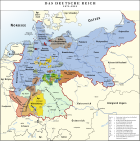
Grand Duchies Duchies Anhalt · Brunswick · Saxe-Altenburg · Saxe-Coburg and Gotha · Saxe-Lauenburg (until 1876) · Saxe-MeiningenPrincipalities Schaumburg-Lippe · Schwarzburg-Rudolstadt · Schwarzburg-Sondershausen · Lippe · Reuss Elder Line · Reuss Junior Line · Waldeck-PyrmontCity-states Other territories Categories:- Former monarchies of Europe
- Former countries in Europe
- States of the Holy Roman Empire
- States and territories established in the 11th century
- States and territories disestablished in 1918
- 1918 disestablishments
- Württemberg
- House of Württemberg
- Swabian League
Wikimedia Foundation. 2010.

